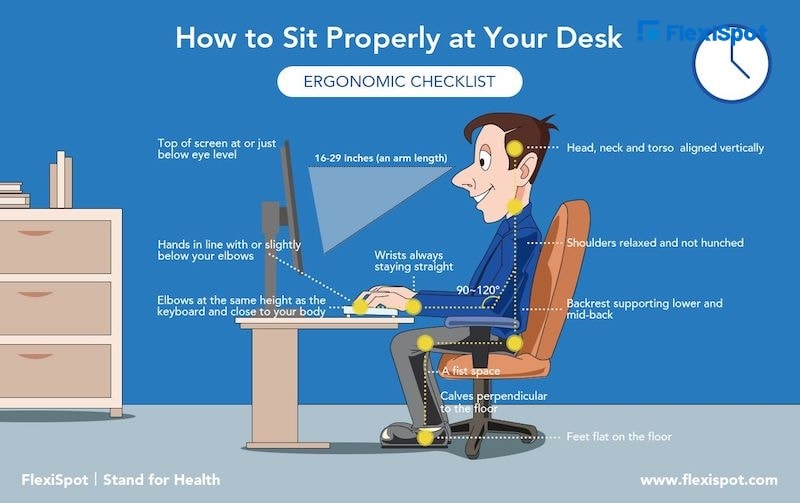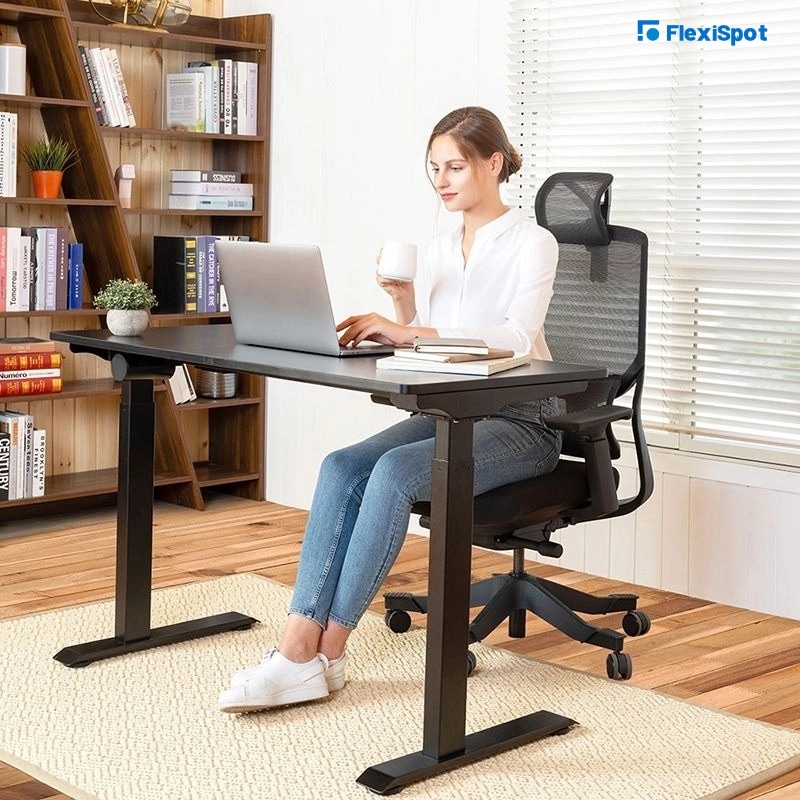You might think, "I've been sitting my whole life - how much more is there to know?" But learning how to sit properly at your desk is vital for muscle and joint health. Among other benefits, correct posture aligns bones and joints to allow for proper muscle use, prevents fatigue, and decreases wear and stress on joints - therefore decreasing arthritis risk. If you're sitting for several hours every weekday at your job, that time adds up, so make sure you're training your body correctly instead of building up bad habits.
One note before beginning: A vital piece of proper seated posture is use of a height adjustable chair. This will allow for maximum customization ability to reach the correct height relative to your other workstation components.
Lower Body Positioning
Let's start from the ground up. Your feet should be flat on the floor. Legs should create a right angle at the knee, with thighs parallel to the floor and calves perpendicular. If your chair ends up being too high when you adjust for use with your desk, use a footrest to achieve this position to provide support for your feet and legs.
The seat depth of your selected chair should allow for your lower and mid-back to be supported by the chair's lumbar support, while also making sure the backs of your knees are not touching the front edge of the seat. One trick to remember is to place a fist behind your knee - there should be space for it to fit between you and the chair.

Upper Body Positioning
Your forearms should ideally be supported with arm rests when resting or using only your mouse. For keyboard use, elbows should be at about the same height as the keyboard - whether this is accomplished with the height of the desk itself or with a separate adjustable keyboard tray.
Wrists should always stay straight so that hands and forearms move as a unit. It's especially important that your keyboard is not too high, as bending wrists back can cause strain and lead to carpel tunnel syndrome. Wrist rests are generally not a good idea, as wrists should float when you're typing; any support should be for the forearms. Adjust your desk, keyboard tray or chair to reach correct typing height and angle.
Elbows and upper arms should stay close to your body to avoid arm and shoulder strain. Your shoulders should always be relaxed and not hunched - which is a great tip for posture in general!
The monitor should be about an arm's length away (an average of 16 to 29 inches), and the top of the screen should be level with your gaze when sitting up straight with your head and neck aligned with your torso. Use a separate, adjustable monitor arm if needed to reach the correct height.
Enhance Sitting with Occasional Standing
While sitting properly can improve your health and prevent ergonomic injuries, an even better workday enhancement is to intersperse standing with sitting throughout the day. Changing positions has shown benefits for both physical and mental health, but it can be difficult if you're not accustomed to standing. To ease into standing, incorporate two hours or standing into the day and gradually increase to four hours.
Recommendations for sitting and standing posture have many similarities. Your head, neck and spine should always be aligned and shoulders relaxed for ideal posture. In both positions, the monitor should be at the same distance away and at the same height relative to your eyes. Elbows should be kept close to the body, bent at roughly a right angle (no less than 90 degrees, but slightly more is acceptable), and wrists straight. A height adjustable desk makes proper sitting and standing positioning easy - everything will stay the same except your starting height!
Get Moving!
Whether sitting or standing, take breaks two to three times per hour to move around - stretch, refill your water bottle, ask a colleague a question in person instead of by email or take a quick lap around the office. Listen to your body and make adjustments if you are uncomfortable. Practicing how to sit properly at your desk will give you a foundation for good posture that you can carry into the rest of your life - for a happy, aligned body wherever you go!




